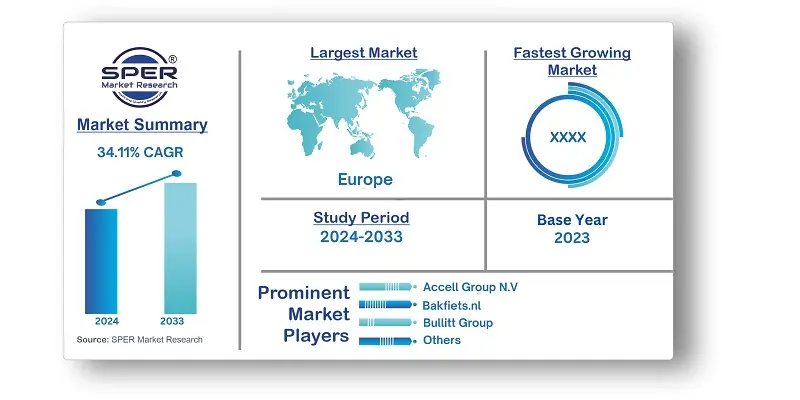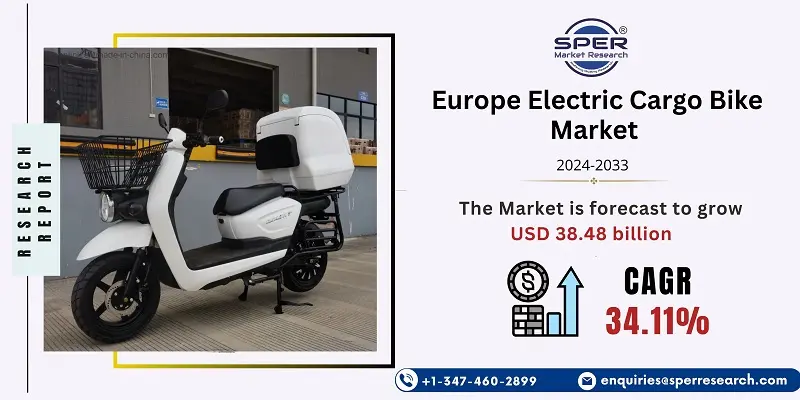
Europe Electric Cargo Bike Market Growth, Size, Trends, Share, Demand and Future Outlook
Europe Electric Cargo Bike Market Size- By Product Type, By Battery Type, By End User- Regional Outlook, Competitive Strategies and Segment Forecast to 2033
| Published: Jun-2024 | Report ID: AMIN24142 | Pages: 1 - 155 | Formats*: |
| Category : Automotive & Transportation | |||
- October 2022; A French company called Douze Cycles had introduced a line of cargo bikes that include four versions, three of which have electric assistance. The bike series has an exceptional towing capacity of up to 205 kg.
- February 2021; The Yuba Kombi E5, the company’s most reasonably priced electric cargo bike, was introduced. The $3200 Shimano E5000 mid drive motor system powers the electric cargo bike, which is intended to appeal to more budget conscious cyclists.

Market Opportunities and Challenges

| Report Metric | Details |
| Market size available for years | 2020-2033 |
| Base year considered | 2023 |
| Forecast period | 2024-2033 |
| Segments covered | By Product Type, By Battery Type, By End-User |
| Regions covered | Northern, Central, Western, Eastern, Southern |
| Companies Covered | Accell Group N.V., Bakfiets.nl, Bullitt Group, Butchers & Bicycles, Douze Cycles, Rad Power Bikes, Riese & Müller, RYTLE GmbH, Urban Arrow, and Winther Bikes. |
- Urban Commuters
- Families
- Small Businesses
- Delivery and Logistics Companies
- Eco-conscious Consumers
- Municipal and Government Services
- Retailers and Supermarkets
- Tourist and Leisure Services
- Educational Institutions
- Healthcare and Community Services
| By Product Type: |
|
| By Battery Type: |
|
| By End-Users: |
|
- Europe Electric Cargo Bike Market Size (FY’2024-FY’2033)
- Overview of Europe Electric Cargo Bike Market
- Segmentation of Europe Electric Cargo Bike Market by Product Type (Two-wheeler, Three-wheeler, Four-wheeler)
- Segmentation of Europe Electric Cargo Bike Market by Battery Type (Lithium-ion, Lead Based, Nickel Based)
- Segmentation of Europe E-cargo Bike Market by End-User (Courier and Parcel Service, Service Delivery, Personal Use, Large Retail Suppliers, Others)
- Statistical Snap of Europe Electric Cargo Bike Market
- Expansion Analysis of Europe E-cargo Bike Market
- Problems and Obstacles in Europe Electric Cargo Bike Market
- Competitive Landscape in the Europe E-cargo Bike Market
- Impact of COVID-19 and Demonetization on Europe Electric Cargo Bike Market
- Details on Current Investment in Europe Electric Cargo Bike Market
- Competitive Analysis of Europe E-cargo Bike Market
- Prominent Players in the Europe Electric Cargo Bike Market
- SWOT Analysis of Europe Electric Cargo Bike Market
- Europe E-cargo Bike Market Future Outlook and Projections (FY’2024-FY’2033)
- Recommendations from Analyst
1.1 Scope of the report1.2 Market segment analysis
2.1 Research data source2.1.1 Secondary Data2.1.2 Primary Data2.1.3 SPER’s internal database2.1.4 Premium insight from KOL’s2.2 Market size estimation2.2.1 Top-down and Bottom-up approach2.3 Data triangulation
4.1 Driver, Restraint, Opportunity and Challenges analysis4.1.1 Drivers4.1.2 Restraints4.1.3 Opportunities4.1.4 Challenges4.2 COVID-19 Impacts of the Europe Electric Cargo Bike Market.
5.1 SWOT Analysis5.1.1 Strengths5.1.2 Weaknesses5.1.3 Opportunities5.1.4 Threats5.2 PESTEL Analysis5.2.1 Political Landscape5.2.2 Economic Landscape5.2.3 Social Landscape5.2.4 Technological Landscape5.2.5 Environmental Landscape5.2.6 Legal Landscape5.3 PORTER’s Five Forces5.3.1 Bargaining power of suppliers5.3.2 Bargaining power of buyers5.3.3 Threat of Substitute5.3.4 Threat of new entrant5.3.5 Competitive rivalry5.4 Heat Map Analysis
6.1 Europe Electric Cargo Bike Market Manufacturing Base Distribution, Sales Area, Product Type6.2 Mergers & Acquisitions, Partnerships, Product Launch, and Collaboration in Europe Electric Cargo Bike Market
7.1 Europe Electric Cargo Bike Market Size, Share and Forecast, By Product Type, 2020-20267.2 Europe Electric Cargo Bike Market Size, Share and Forecast, By Product Type, 2027-20337.3 Two-wheeler7.4 Three-wheeler7.5 Four-wheeler
8.1 Europe Electric Cargo Bike Market Size, Share and Forecast, By Battery Type, 2020-20268.2 Europe Electric Cargo Bike Market Size, Share and Forecast, By Battery Type, 2027-20338.3 Lithium-ion8.4 Lead Based8.5 Nickel Based
9.1 Europe Electric Cargo Bike Market Size, Share and Forecast, By End-Users, 2020-20269.2 Europe Electric Cargo Bike Market Size, Share and Forecast, By End-Users, 2027-20339.3 Courier and Parcel Service9.4 Service Delivery9.5 Personal Use9.6 Large Retail Suppliers9.7 Others
10.1 Europe Electric Cargo Bike Market Size and Market Share
11.1 Europe Electric Cargo Bike Market Size and Market Share By Region (2020-2026)11.2 Europe Electric Cargo Bike Market Size and Market Share By Region (2027-2033)11.3 Central Europe11.4 Eastern Europe11.5 Northern Europe11.6 Western Europe
12.1 ACCELL GROUP N.V.12.1.1 Company details12.1.2 Financial outlook12.1.3 Product summary12.1.4 Recent developments12.2 BAKFIETS.NL12.2.1 Company details12.2.2 Financial outlook12.2.3 Product summary12.2.4 Recent developments12.3 BULLITT GROUP12.3.1 Company details12.3.2 Financial outlook12.3.3 Product summary12.3.4 Recent developments12.4 BUTCHERS AND BICYCLES12.4.1 Company details12.4.2 Financial outlook12.4.3 Product summary12.4.4 Recent developments12.5 DOUZE CYCLES12.5.1 Company details12.5.2 Financial outlook12.5.3 Product summary12.5.4 Recent developments12.6 RAD POWER BIKES12.6.1 Company details12.6.2 Financial outlook12.6.3 Product summary12.6.4 Recent developments12.7 RIESE AND MÃœLLER12.7.1 Company details12.7.2 Financial outlook12.7.3 Product summary12.7.4 Recent developments12.8 RYTLE GMBH12.8.1 Company details12.8.2 Financial outlook12.8.3 Product summary12.8.4 Recent developments12.9 WINTHER BIKES12.9.1 Company details12.9.2 Financial outlook12.9.3 Product summary12.9.4 Recent developments12.10 Others
SPER Market Research’s methodology uses great emphasis on primary research to ensure that the market intelligence insights are up to date, reliable and accurate. Primary interviews are done with players involved in each phase of a supply chain to analyze the market forecasting. The secondary research method is used to help you fully understand how the future markets and the spending patterns look likes.
The report is based on in-depth qualitative and quantitative analysis of the Product Market. The quantitative analysis involves the application of various projection and sampling techniques. The qualitative analysis involves primary interviews, surveys, and vendor briefings. The data gathered as a result of these processes are validated through experts opinion. Our research methodology entails an ideal mixture of primary and secondary initiatives.



Frequently Asked Questions About This Report
PLACE AN ORDER
Year End Discount
Sample Report
Pre-Purchase Inquiry
NEED CUSTOMIZATION?
Request CustomizationCALL OR EMAIL US
100% Secure Payment






Related Reports
Our Global Clients
Our data-driven insights have influenced the strategy of 200+ reputed companies across the globe.




















